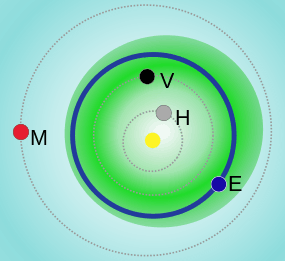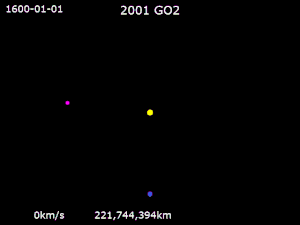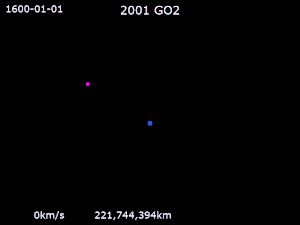2001 GO2
2001 GO2 is a small asteroid that is a near-Earth object, an Earth coorbital,[5] and an Apollo asteroid.
| Discovery[1] | |
|---|---|
| Discovered by | Lincoln Laboratory ETS (now LINEAR) |
| Discovery site | Socorro, New Mexico, USA |
| Discovery date | April 13, 2001 |
| Designations | |
| 2001 GO2 | |
| MPO 30455 | |
Apollo  NEO | |
| Orbital characteristics[2] | |
| Epoch 13 January 2016 (JD 2457400.5) | |
| Uncertainty parameter 6 | |
| Observation arc | 5[1][3] d |
| Aphelion | 1.17583 AU (175.902 Gm) |
| Perihelion | 0.83753 AU (125.293 Gm) |
| 1.00668 AU (150.597 Gm) | |
| Eccentricity | 0.16803 |
| 1.01 yr (368.92 d) 1.01 yr | |
Average orbital speed | 29.474 km/s |
| 305.54° | |
| 0° 58m 32.916s /day | |
| Inclination | 4.6199° |
| 193.546° | |
| 265.48° | |
| Earth MOID | 0.00411326 AU (615,335 km) |
| Jupiter MOID | 3.92432 AU (587.070 Gm) |
| Physical characteristics | |
| Dimensions | 35–85 m[4] |
| 24.3[2] | |
Orbit
With an orbital period of 368.95 days, 2001 GO2 is in a near 1:1 orbital resonance with Earth, and also has about the same orbit around the Sun as Earth.[2] Unlike most near-Earth asteroids that simply fly by when they approach Earth, the Earth catches up with this asteroid from behind so that the asteroid then pauses in the vicinity of Earth. While in the vicinity of Earth, the asteroid moves in a helical (corkscrew) pattern that resembles an orbit around the Earth, like the Earth has a new moon. But it is not really a moon, because the asteroid is not gravitationally bound to the Earth, and eventually the asteroid moves on away from Earth and continues its orbit around the Sun. 2001 GO2 was in this helical pattern from about 1997 to 2005, making the closest approach to Earth on 6 April 2001, and will not make another close approach until 2092.[6]
The asteroid probably has a horseshoe orbit, but this has not been proven because the orbit was determined from only 5 days worth of observation.[3] The Jupiter Tisserand invariant, used to distinguish different kinds of orbits, is 6.033.[2]
Other asteroids that move in this helical pattern, some of which the Earth catches up with the asteroid, and others in which the asteroid catches up with Earth, are 2003 YN107, 2002 AA29, and (164207) 2004 GU9.[5]



See also
- 3753 Cruithne (1986 TO)
- 2002 AA29
- 2003 YN107
- 2006 JY26
- 2010 SO16
- 2012 FC71
- Orbital resonance
References
- "2001 GO2". Minor Planet Center. 9 December 2014.
- "JPL Small-Body Database Browser: (2001 GO2)" (last observation: 2001-04-17; arc: 4 days). Jet Propulsion Laboratory. Retrieved 30 March 2016.
- Christou, Apostolos A.; Asher, David J. (2011). "A long-lived horseshoe companion to the Earth". Preprint. arXiv:1104.0036. Bibcode:2011MNRAS.414.2965C. doi:10.1111/j.1365-2966.2011.18595.x.
- "ABSOLUTE MAGNITUDE (H)". NASA.
- "Corkscrew Asteroids". NASA. 9 June 2006.
- "JPL Close-Approach Data: (2001 GO2)" (last observation: 2001-04-17; arc: 4 days). Jet Propulsion Laboratory. Retrieved 26 April 2015.